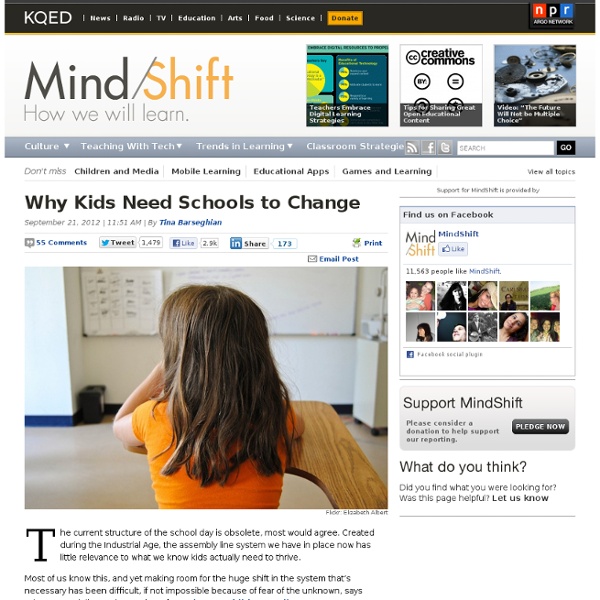The Learning Corner - Reflections on Education, Technology, Leadership, and Innovation
9 Characteristics Of 21st Century Learning
The label of “21st Century learning” is vague, and is an idea that we here at TeachThought like to take a swing at as often as possible, including: –weighing the magic of technology with its incredible cost and complexity –underscoring the potential for well thought-out instructional design –considering the considerable potential of social media platforms against its apparent divergence from academic learning Some educators seek out the ideal of a 21st century learning environment constantly, while others prefer that we lose the phrase altogether, insisting that learning hasn’t changed, and good learning looks the same whether it’s the 12th or 21st century. At TeachThought, we tend towards the tech-infused model, but do spend time exploring the limits and challenges of technology, the impact of rapid technology change, and carefully considering important questions before diving in head-first. The size of the circles on the map are intended to convey priority. 1. 2. 3. 4. 5. 6. 7. 8. 9.
AllThingsPLC — Research, education tools and blog for building a professional learning community
Professional development reform: 8 steps to make it happen SmartBlogs
Every year, school districts around the country waste a tremendous amount of time and money on ineffective professional development. The traditional model of “sit and get,” where a one-size-fits-all approach is utilized, yields abhorrent results. Ask teachers from typical school districts in America their thoughts on traditional in-service time, and the feedback won’t be pretty. Professional development in many districts must undergo radical reform, from a model that’s outdated and ineffective to one that’s differentiated, meaningful and engaging. How can school districts reform their professional development? Clearly define and articulate the vision. To be successful, professional development must be a core value of all stakeholders and an ongoing, outcome-based process, where the accountability for growth is high. Tom Murray serves as the director of technology and cybereducation for the Quakertown Community School District in Bucks County, Pa. Related Posts
PLA:Professional Learning Communities
All Fairfax County Public Schools operate as professional learning communities that employ best practices to raise the bar for all students and close the achievement gap. Definition In a professional learning community (PLC): Educators are committed to working collaboratively in ongoing processes of collective inquiry and action research to achieve better results for the students they serve. The school system operates under the assumption that the key to improved learning for students is continuous job-embedded learning for educators. Schools are composed of collaborative teams. FCPS Shared Vision PLC Project Scope & Resourcing Definition - Update FCPS PLC Goals and Priorities PLC Fundamentals A document which captures FCPS' shared vision of a professional learning community FCPS PLC Vocabulary A document which ensures that all FCPS leaders have a shared understanding of critical terms FCPS Collaborative Teams at Work (video)
Thomas R. Guskey
Dr. Thomas R. Guskey is an expert in evaluation design, analysis, and educational reform. He is a professor at the University of Kentucky, as well as an education consultant who has worked with educators in all 50 states, Europe, and Asia. Dr. Dr. Dr. From our products featuring Dr. Consider carefully the most important purposes of grading.
Welcome to the Atlas Education Centre | Atlas Education Centre
The Atlas Education Centre opened its doors in 2005 and became the first educational and training facility devoted entirely to curriculum development and the sharing of best practices. Participants come from all over the globe come to collaborate, network and exchange ideas on the curriculum process. At Rubicon, we are committed to being the world-wide leader in Curriculum Mapping and provide our clients with the best possible training and professional development support. The Atlas Education Centre was designed and developed by teachers for:TeachersCurriculum DirectorsAcademic DeansInstructional SpecialistsAdministrators Located in the World Trade Center in beautiful downtown Portland, Oregon, the Atlas Education Centre incorporates the latest in instructional technology, while providing an international forum and a platform for professional exchange. What makes the experience unique:
Twitter + YouTube+ Google+ = A New Kind Of PD
Yesterday, I fell into an amazing experience. To take a term from Laura Robertson’s blog post,“You Say You Want a Revolution: EdcampHome,” it felt “revolutionizing.” EdcampHome I was on Twitter when I saw hashtags from people I follow discussing the #EdcampHome experience. I quickly realized this was an opportunity to attend an Edcamp at home. According to Wikipedia, Edcamp is defined as “a user-generated conference – commonly referred to as an “unconference“. I went to the homepage of EdcampHome and saw four amazing educators: David Theriault, Karl Lindgren-Streicher, Kelly Kermode, and Shawn White troubleshooting, discussing and working diligently to put this together via a Google Hangout being streamed live through YouTube and simultaneously embedded on the front page of the website. At one point, I tweeted to thank them for all their hard work and to remind them to breathe. Sessions Streamed Live Slam Dunk! I joined the closing and the “Slam” portion at the end. Power of the Positive



